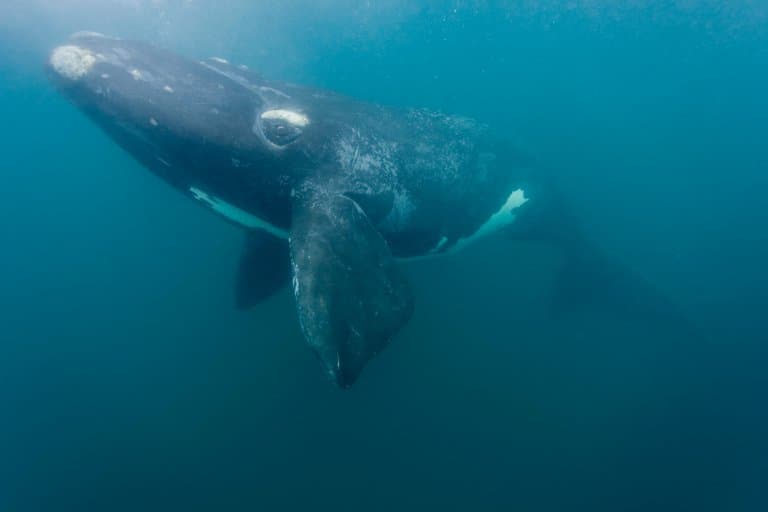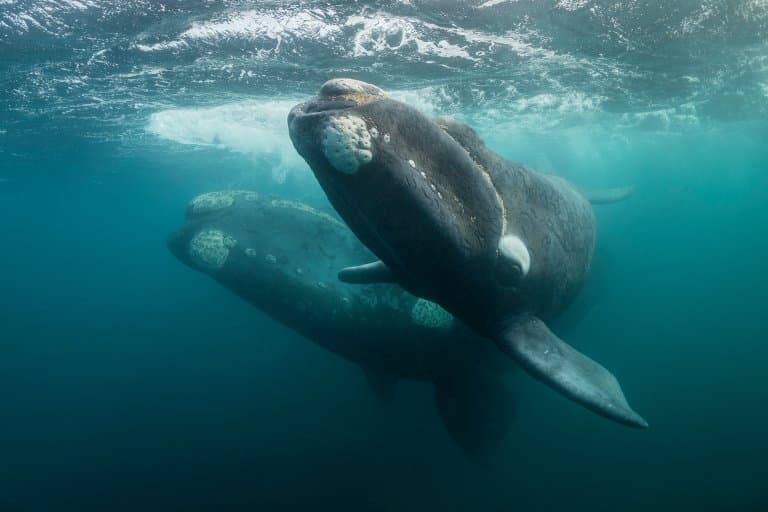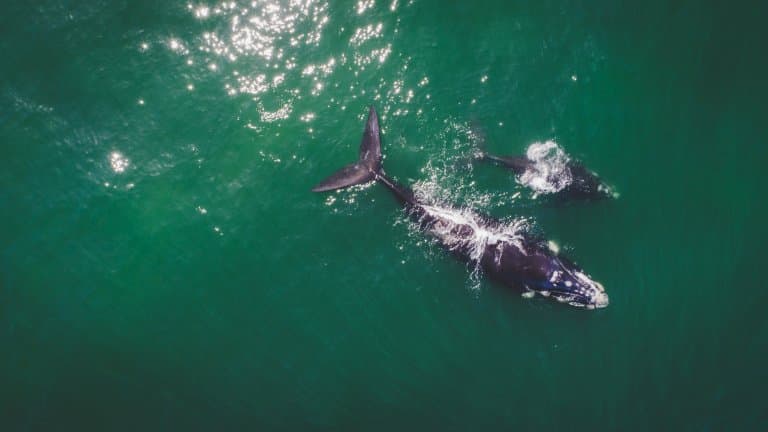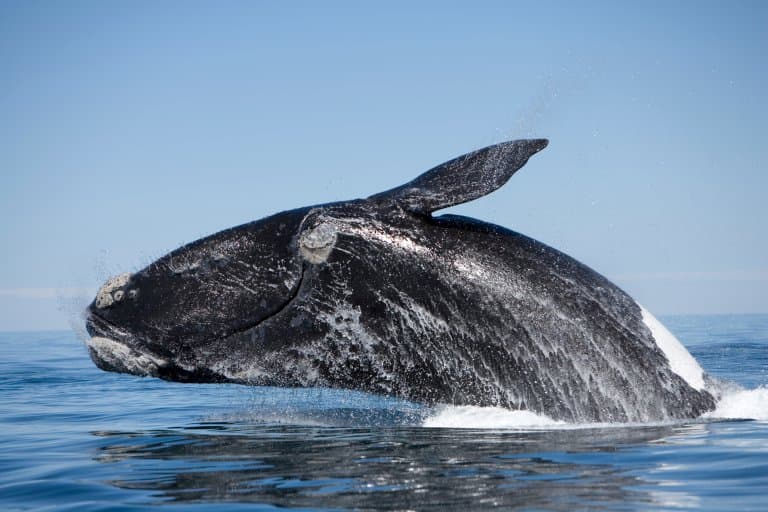Right Whale Profile
Right whales are made up of three separate species of the genus Eubalaena, which are baleen whales.
The three species differ genetically and by location, but are very similar in appearance. They are found in the North Atlantic, North Pacific and South Pacific oceans respectively, where they inhabit mainly continental shelf waters and travel to deeper waters for feeding grounds.
Right whales are easily identified by their lack of dorsal fins and their very stocky bodies – their girth can in fact be up to 60% of their total body length.

Right Whale Facts Overview
| Habitat: | Temperate waters, often near coast |
| Location: | Atlantic and Pacific oceans |
| Lifespan: | 50-100 years in ideal circumstances |
| Size: | Up to 56 feet in length (13 – 17m) |
| Weight: | Around 70 tons |
| Color: | Black, some white patches |
| Diet: | Zooplankton, copepods, krill |
| Predators: | No natural predators |
| No. of Species: | 3 |
| Conservation Status: | North Atlantic right whale is Critically Endangered, North Pacific right whale is Endangered, and Southern right whale is of least concern |
They are predominantly black, with some irregular white patches on their bellies and heads. They have wide, smooth-edged tails with a deep notch and distinctive v-shaped blow holes (unique among other large whale species).
Their pectoral flippers are fairly short and wide, and are paddle shaped. Due to the giant baleen in their mouths, they have a strongly arched mouthline which ends below the eye. Females of the species are larger than the males, and can weigh about 140,000 lbs.
Being baleen whales, right whales feed by swimming slowly through groups of plankton and copepods with their mouths open. Their ‘baleen’ – a sieve like structure made of dense hair, bristles and baleen plates – collects the plankton as they move through the water.
Their baleens can be up to 8 feet in size. Northern right whales feed mainly on copepods (tiny crustaceans), while southern right whales eat more krill. They tend to calve and nurse in shallow bays and coastal waters, while feeding usually occurs in deeper waters. Scientists believe that right whales can eat between 2,200 and 5,500 pounds of food every day.
Right whales are the rarest of all large whales. Their populations grow slowly, as females don’t become sexually mature until around 10 years of age and give birth to a single calf after a 12-month pregnancy. Mating has been observed during any season, but females give birth during December to March (in Northern right whales) and July to September (Southern).
All 3 species of right whale are migratory, moving seasonally to feed or give birth.
They usually have one calf every three years; allowing their bodies to fully recover from the demands of pregnancy, birth and nursing.
Newborns are between 4 and 6 metres in length and weigh around 1 ton. The calf will remain with its mother for a full year. During this time, it will double in size, and will learn the best feeding sites and locations which it will use for the rest of its life.
Interesting Right Whale Facts
1. All right whales can be recognized by their huge heads
There are several species of right whale, but they are all identified by the enormous size of their heads and jaws, which can be up to one third of their body size. 1

2. Right whales are identified by the unique rough skin patches and callosites on their heads
These rough patches of scaly skin appear white in colour due to whale lice (cyamids) which cover their dark skin.
The patches are known as callosities, and are uniquely shaped for each individual whale.
Scientists use the unique patterns of callosities to distinguish between whales and identify individuals, therefore being able to track their movements and behaviour.
3. Right whales were named by whalers
The name right whale came from whalers who identified these giant specimens as the ‘right’ whales to hunt. Right whales were actually the first whales to be hunted, from as early as the 11th century.
During the 17th, 18th and 19th centuries, right whale populations plummeted almost to the point of extinction because of the whaling industry.
Right whales were sought after for their oil and baleen, which was used for items such as corsets and whips. They were considered easier to hunt as they tended to remain close to shore and move slowly.
Right whales’ thick blubber also causes them to float on the surface after being killed, which was convenient for the whalers. 2

4. Right whales are protected
There has been complete international protection of right whales since 1949.
Populations of Southern right whales have shown some encouraging growth since this protection; Northern right whales are the most at risk. 3
5. Right whales are not aggressive
Unlike some other whale species, such as the humpback, male right whales do not exhibit aggressive or possessive behaviour during mating.
It is believed that the males compete to pass their genes to the next generation through the quantity of sperm that they produce when they mate, rather than fighting to attain the female’s attentions.
In fact, females will often mate with several males successively.
6. Right whales have the largest testes of any animal on earth
These can weigh up to 500kg each! They also have extremely large penises!
7. The social lives of right whales are still unknown
These creatures are still quite mysterious and relatively little is known about their lifestyles and habits due to their sparse populations.
While right whales usually appear to be travelling and eating alone, sound recordings have indicated that they are frequently in contact with one another through acoustic communication. 4

8. They are acrobatic despite their size
Although they are not very often seen at the water’s surface, the enormous right whales have been known to breach (leap above the water), and also to slap their tails and fins on the surface.
9. Groups of whales at the water’s surface are known as SAGs
This acronym stands for surface-active groups, and in these groups, whales will socialise and mate at the surface of the water. Mating has been observed in all seasons and habitats.
10. Humans still pose the greatest threat to this species
Even thought whaling is no longer a threat, human interaction is still threatening the survival of this species. They were never able to recover to pre-whaling numbers, meaning that the population size is still very small.
There is significant dangers due to entanglement in nets and trawls, as well as vessel strikes. Increased ocean noise levels are also a concern, as this impairs the whales’ ability to communicate with one another and increases stress levels.
Climate change also has a huge impact, as warming seawaters and changes in currents and winds can shift feeding availability and abundance. 5

Right Whale Fact-File Summary
Scientific Classification
| Kingdom | Animalia |
| Phylum | Chordata |
| Class | Mammalia |
| Order | Artiodactyla |
| Infraorder | Cetacea |
| Family | Balaenidae |
| Genus | Eubalaena |
| Species | North Atlantic right whale (E. glacialis) North Pacific right whale (E. japonica) Southern right whale (E. australis). |
Fact Sources & References
- “North Atlantic Right Whale”, NOAA Fisheries.
- “Right Whales”, National Geographic.
- “North Atlantic Right Whale”, Defenders of Wildlife.
- “Western South Atlantic Southern Right Whale”, International Whaling Comission.
- “North Atlantic Right Whale – Eubalaena glacialis”, Mammal Society.
